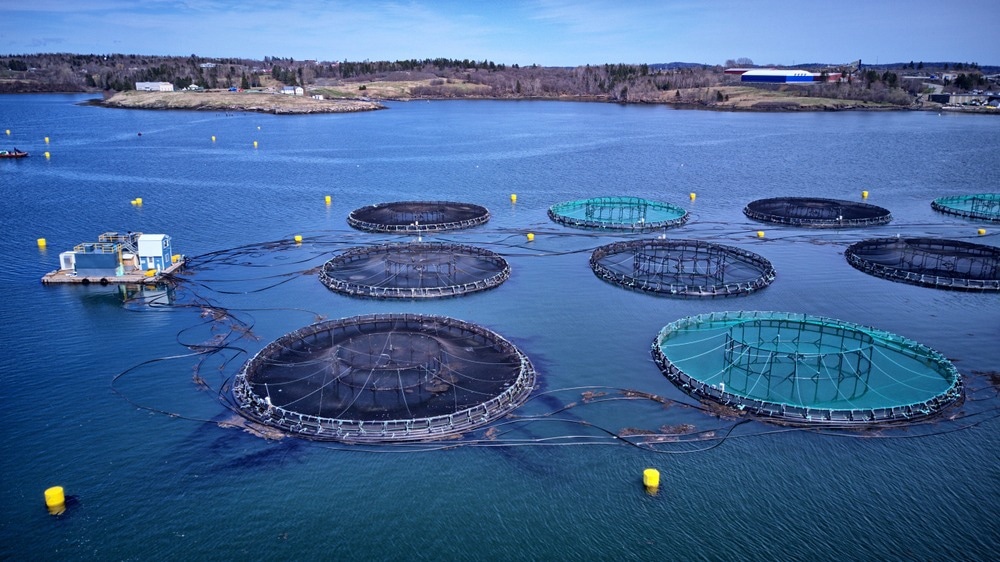Selenium (Se) is an essential element found in aquatic feeds that promotes the proper development, wellbeing, and fitness of marine animals. Selenium can be transformed into nanomaterials that are more easily accessible, absorbed, and consumed by aquatic species using nanotechnology.

Study: Embracing nanotechnology for selenium application in aquafeeds. Image Credit: leo w kowal/shtuterstock.com
A paper published recently in the journal Reviews in Aquaculture provides a complete assessment of the effects of Se and Se nanoparticles (Se-NPs) in aquafeeds on marine animals. The study shows that nanoparticles can boost the usage and retention of Se in aquafeeds while lowering its toxicity.
Nanotechnology in Aquaculture Industry
The human population is expected to grow significantly, reaching around nine billion individuals by 2050. This is projected to put additional strain on the food manufacturing industry as it reacts to rising demand. Aquaculture, the fastest-growing food generation sector, has made substantial contributions to worldwide food and nutritional sustainability.
However, the sector's long-term viability is jeopardized by growing feed prices as traditional feed materials become scarce and costly. To meet the blue economy aims, efforts have been undertaken to improve the accessibility and usage of current components.
Nanotechnology utilization is a new but extremely promising technical innovation in the aquaculture sector. Nanomaterials and emulsion-based methods can be used in aquafeed development, disease management, and water filtration.
Nanomaterials can significantly improve the resource utilization of aquaculture resources including medications, vaccines, powdered feeding, and even gene transfer.
Selenium (Se): A Vital Microelement in Aquatic Animals
Selenium (Se) is an essential microelement in marine animals with both nutritional and cytotoxic effects. Compared with organic components, the inorganic species of Se travels quickly through the fish intestines and has poor absorption and digestion. As a result, organic Se is suggested as the primary type of Se supplement in the diets of aquatic animals.
Selenium nanoparticles (Se-NPs) have lately shown several uses in aquafeeds due to their high absorption and anti-oxidation capabilities in marine animals. Se-NPs have been widely studied in aquafeeds, with documented advantages including improved growth efficiency, nutrient uptake, antioxidant effectiveness, immunological response, and infection resistance.
Disadvantages of Selenium Nanoparticles (Se-NPs) as Aquafeeds
Despite the many prospective advantages of Se-NPs in aquaculture, their usage can be hampered by a lack of understanding of dose-response impacts on fish quality and product safety.
Se-NPs have a restricted range of consumption in fish diets because larger amounts might be poisonous. At the same time, a lack of these important components could harm fish health by inducing tissue damage and decreasing physiological activities.
Limitations of Previous Studies
Investigations on the effects of Se consumption and its nanoscale particles in aquaculture have been oriented mostly toward fish populations, with little attention paid to other marine animals. As a result, significant gaps in current understanding remain, notably regarding the responsiveness of shrimps and crustaceans to diets supplemented with Se and Se-NPs.
Some economically important species and developmental stages have also been overlooked in prior research, limiting the use of nanomaterials in aquafeed synthesis and production.
Highlights of the Current Work
Selenium is an essential nutrient aquatic animals need for appropriate development and physiological activities. It has shown significant benefits, including increased feed efficiency, nutritional digestion, blood circulation, intestinal morphology, antioxidant properties, immunology, and tolerance to infections and environmental contaminants.
However, the needed amounts in the diets vary depending on the aquatic species, and any variation from the acceptable range has negative consequences due to the high toxicity of Se.
The positive benefits of Se may be boosted by nanotechnology by transforming it to its nanoparticle form (Se-NPs), which is better absorbed by animals and has a broader intake range. Because aquatic animals easily digest Se-NPs, they may satisfy nutritional needs in aquafeeds at low inclusion concentrations.
Future Outlook and Avenues for Further Research
In the future, investigators should study all developmental periods of both fish and crustaceans to identify the most important aquaculture species in domestic and foreign markets. Molecular techniques should be employed to acquire a thorough understanding of the regulatory mechanisms that Se-NPs use to boost the antioxidant activities and immunology of marine animals.
This would be essential information for the industrialization of aquaculture nanoscale materials. Future studies on including Se-NPs in aquaculture diets can lead to significant gains in fish productivity, ecological sustainability, and disease management throughout the aquaculture sector.
Reference
Khalil, H. S. et al. (2022). Embracing nanotechnology for selenium application in aquafeeds. Reviews in Aquaculture. Available at: https://onlinelibrary.wiley.com/doi/10.1111/raq.12705
Disclaimer: The views expressed here are those of the author expressed in their private capacity and do not necessarily represent the views of AZoM.com Limited T/A AZoNetwork the owner and operator of this website. This disclaimer forms part of the Terms and conditions of use of this website.